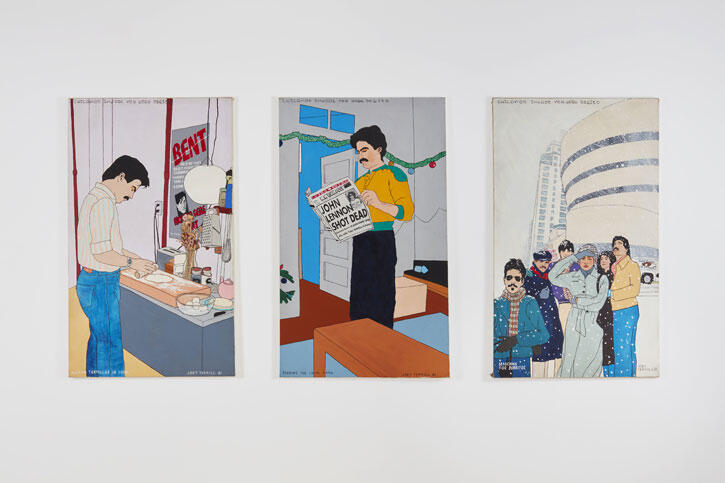Joey Terrill’s Intimate Canvases of Chicano Masculinity
The artist’s deft and personal paintings documenting gay Chicano culture in the 1980s and ’90s take centre stage at Ortuzar Projects, New York
The artist’s deft and personal paintings documenting gay Chicano culture in the 1980s and ’90s take centre stage at Ortuzar Projects, New York

‘Once Upon A Time: Paintings, 1981–2015’ at Ortuzar Projects, Joey Terrill’s first exhibition in New York in 40 years, sheds some much-needed light on the artist’s distinctive practice. Terrill turns pop art’s hard-edged, almost cold sterility into sensitive, confessional and humorous canvases that document living, working and fucking as a gay Chicano in Los Angeles and New York. Perhaps best known for his t-shirts emblazoned with the words maricón and malflora (Spanish slang for ‘faggot’ and ‘dyke’, respectively), which he and fellow marchers wore at the 1976 Gay Parade in Los Angeles, Terrill’s role as a gay activist and critic of Chicanismo has often overshadowed his considerable painting output. Yet, his canvases share with his activist work a keen interest in American pop culture, an awareness of racial and sexual marginalization, the ups and downs of gay life as well as the challenges of living with HIV. (He tested positive in 1989.)

One of the earliest works on display, the series 'Chicanos Invade New York' (1981), shows Terrill and friends trying to navigate New York as recent transplants. In the first painting of three paintings, he’s quietly rolling tortillas in a cramped kitchen (Making Tortillas in SoHo); in the second, he’s studying a copy of the New York Post with the headline ‘John Lennon Shot Dead’ (Reading the Local Paper); and, in the third, he and a group of fellow Angelenos are caught in a snowstorm outside the Guggenheim Museum (Searching for Burritos). Painted in a flat, graphic style, each work combines the un-ornamented imagery of Tom Wesselmann with the comic-strip narration of Roy Lichtenstein. Terrill shares with both artists a knack for incorporating advertising and cultural references. In Making Tortillas in SoHo, a large poster promoting Richard Gere in the Broadway play Bent (1979) practically screams from the wall with its clear, simple rendering, and nods to the way gay culture was slowly being matriculated into mass entertainment at the time.

Arguably the show’s magnum opus, Breaking Up / Breaking Down (1984–85) is a multi-canvas chronicle of a relationship’s painful end, similarly sprinkled with references to both clichéd American culture and underground queer literature and film. The ten-panel work begins and ends with self-portraits and includes a series of texts, inscribed on each canvas, that give colour to the story. The first features the artist standing in a dark, swirling maelstrom of skulls and dead animals; the last shows Terrill flexing his biceps in a sunny, Hollywood scene, onto which is written optimistically ‘One Year Later?’ In between, we see his boyfriend driving a car, decked out in luxury goods (‘He wore Ray Ban glasses, a Rolex watch, and he used to eat my ass.’); Terrill jerking off on the couch (‘God, I miss him so much.’); and trying to sleep after burying his misery in drugs. Breaking Up / Breaking Down manages to be at once both explicitly queer and universally relatable, which is the work’s strength: we’ve all been through breakups and we’ve all been through the motions of recovering from one.
Perhaps the most touching piece shows Terrill and his then-boyfriend, Robert Ward, collecting Birds of Paradise flowers among a hyper-detailed menagerie of succulents and cacti (Remembrance, 1989). If Terrill’s stated objective during his long tenure as an artist is to push back against the masculine stereotypes of Chicano culture, this work certainly throws masculinity out of the window or, at least, masculinity as it’s traditionally been conceived. Sensitive and self-reflective, this is masculinity of another sort: one that’s on his terms and no one else’s.
Joey Terrill’s ‘Once Upon A Time: Paintings, 1981–2015’ is on view at Ortuzar Projects, New York, until 23 October.
Main image: Joey Terrill, Breaking Up / Breaking Down, 1984–1985, acrylic on canvas; two panels: 91 × 61 cm each; eight panels: 46 × 61 cm each. Courtesy: the artist and Ortuzar Projects, New York; photography: Timothy Doyon





















